

Originally posted August 7, 2017
The next logical step in the historical single-action revolver chain, after the early Colt percussion revolvers and the Remington New Model Army, is a gun that—in large part thanks to Hollywood—many people have heard of, though not all of them may know very much about it: Colt's Model 1873, sometimes also known as the Model P and probably best-known under the name "Single Action Army" today. This is the iconic cowboy sixgun immortalized in thousands of Western films and TV programs, even though there is some debate as to whether it was really that common on the frontier (we'll get into that later).
In popular culture, the Single Action Army is often known by the nickname "Peacemaker" or as "the gun that won the West" (the latter a title it often has to share with the various Winchester lever-action rifles of 1866 through 1895). It is (I am not making this up) the state firearm of Arizona.¹ Before the advent of the M1911 automatic pistol, this is the gun people invariably meant when they said "Colt .45" (even though that was only one of many cartridges it was offered for). In the late 1940s, the Air Force named a strategic bomber after it, the B-36 Peacemaker.
The Single Action Army's fame and the cachet of the Colt brand mean that original examples are quite valuable nowadays. It's still in production by the present-day Colt's company, but a new one will set you back more than a thousand dollars. Fortunately, that same fame and the popularity of cowboy-themed shooting sports, coupled with the fact that the patents have been expired since the 1890s, means that there is no shortage of reproductions on the market for quite a lot less money. I was able to find one that gives me an excuse to talk about not only the SAA, but also another Colt revolver of the period.
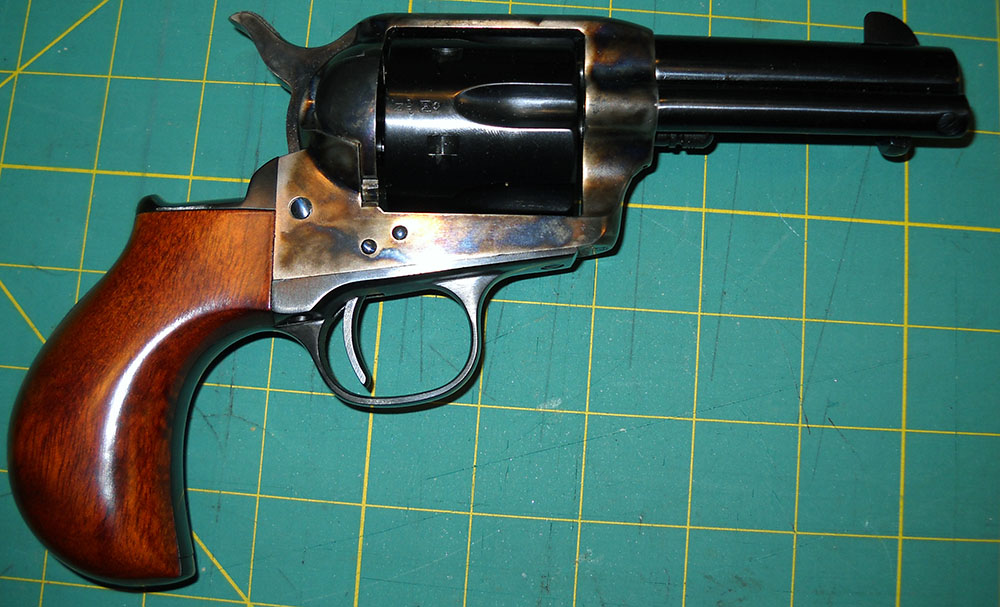
This is a Cimarron Thunderer. Although Cimarron is an American company headquartered in Texas, like many modern reproductions of cowboy-era firearms, most if not all of their products are manufactured under contract in Italy. In this case, the Thunderer is a modified version of the Cattleman, a reproduction Single Action Army made by the firm of Aldo Uberti SRL (part of the Beretta Group).
Basically, the Thunderer is a combination of the body of a Model P (as Cimarron labels its straight-no-chaser version of the Cattleman) and the grip frame of another 1870s Colt revolver, the double-action Model 1877. More about that in a bit. For right now, let's have a closer look at the working parts, which are straight out of the Single Action Army.
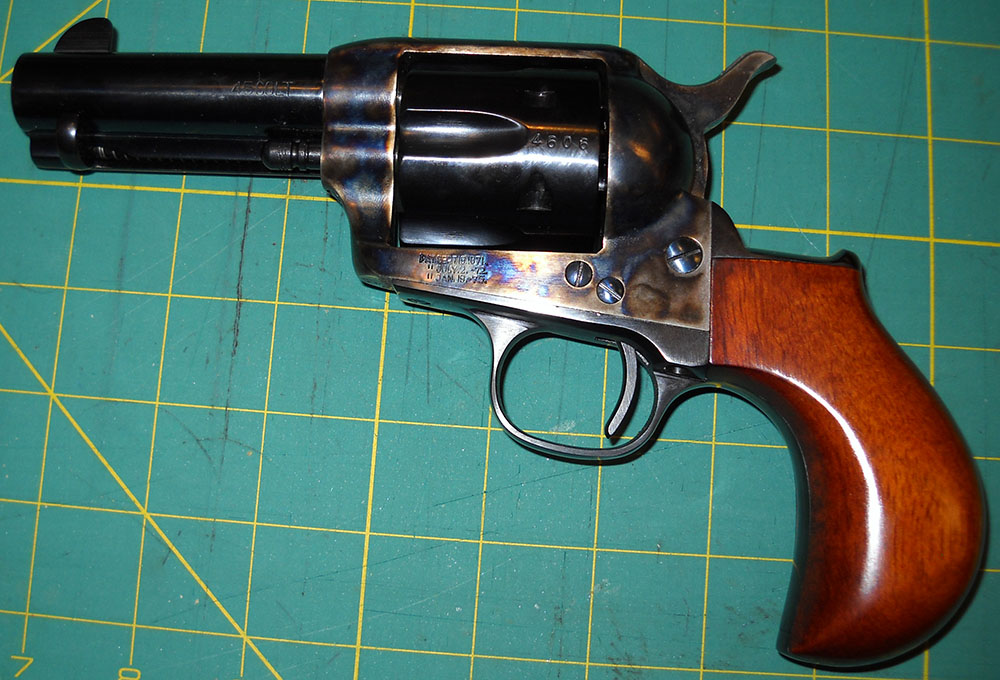
The SAA, as its name makes clear, is a single-action revolver, and in that respect it works in much the same way as its percussion-fired predecessors in Colt's product line: cocking the hammer indexes the cylinder and locks it in place with one of its six chambers aligned with the barrel, and pulling the trigger releases the cocked hammer to fall and fire the round in that chamber, if there is one. There is also a half-cock position in the hammer mechanism, which unlocks the cylinder to rotate and is used for loading.
It differs from earlier Colts in two fundamental ways. First, it was designed from the start to use centerfire metallic cartridge ammunition. Second, and to that end, it has a frame that completely encloses the cylinder at the front, back, top, and bottom.
Previous Colts all had open-topped designs in which the frame covered only the back and bottom of the cylinder, with the cylinder axis pin fixed at the back and the barrel mounted so that its forcing cone was presented directly to the cylinder. As we saw last time, this was simpler to manufacture, easy to disassemble, and less prone to percussion caps slipping off the nipples and jamming in the frame, but also much weaker than the competing Remington percussion revolvers' full-frame construction. For their first foray into the new cartridge technology, Colt's engineers seem to have decided to borrow that page from Remington's playbook.
I'm not sure precisely what the legal status of that design feature was in 1873: whether this indicates that the patent on the original Remington-Beals revolver had expired by that point—the Remington-Beals first appeared in 1858, so it seems unlikely that the patent would have run its course by 1873, unless Beals patented his design some time before Remington was able to bring it to market—or whether the solid frame concept was not sufficiently innovative to warrant patent protection. The latter seems unlikely, in a world where Rollin White's "bore the chambers all the way through" feature could get a patent. At any rate, Colt's new pistol did have a very-Remington-like solid frame, and I've never heard mention of Remington having sued them over it.
Regardless, the timing of the Single Action Army's appearance on the market owes much to the expiration of patents anyway. Colt, unlike Remington, was not one of the manufacturers who chose to pay Smith & Wesson to license the Rollin White bored-chamber patent. Instead, they kept making percussion revolvers with non-completely-bored cylinders until the White patent expired, and only developed a cartridge revolver once they were free to do so without paying their competitor for the privilege.
As a purpose-built cartridge revolver, the SAA has certain advantages over converted percussion designs. Most prominently, unlike many cartridge conversions, it doesn't have to be taken apart to reload it. Instead, it introduced a loading system that went on to be very familiar to revolver users of the late nineteenth and early twentieth centuries: the loading gate.
To load a Single Action Army and many of its later derivatives, first place the hammer at half-cock.
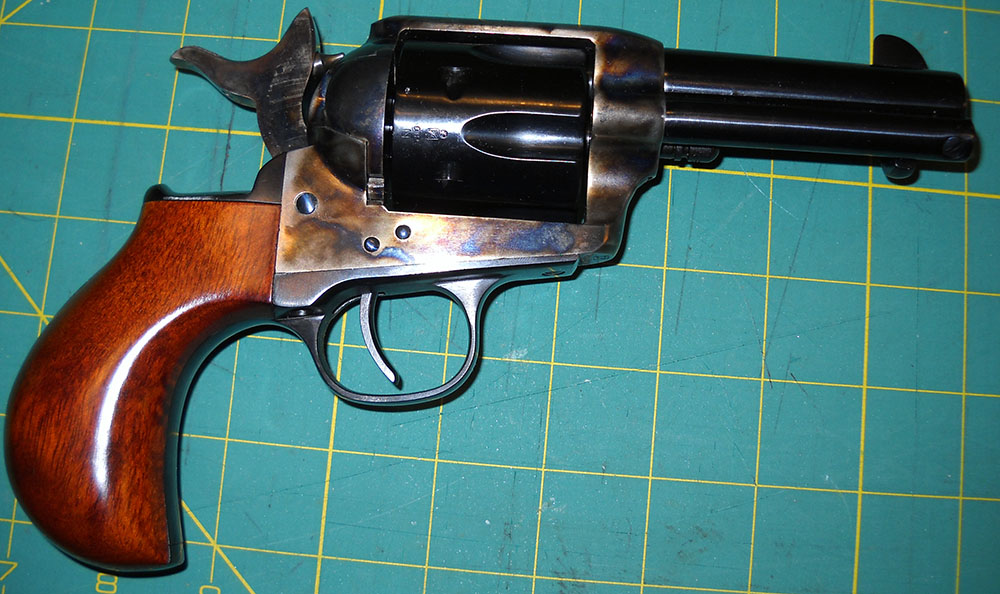
Then flip open the loading gate on the right side of the frame.
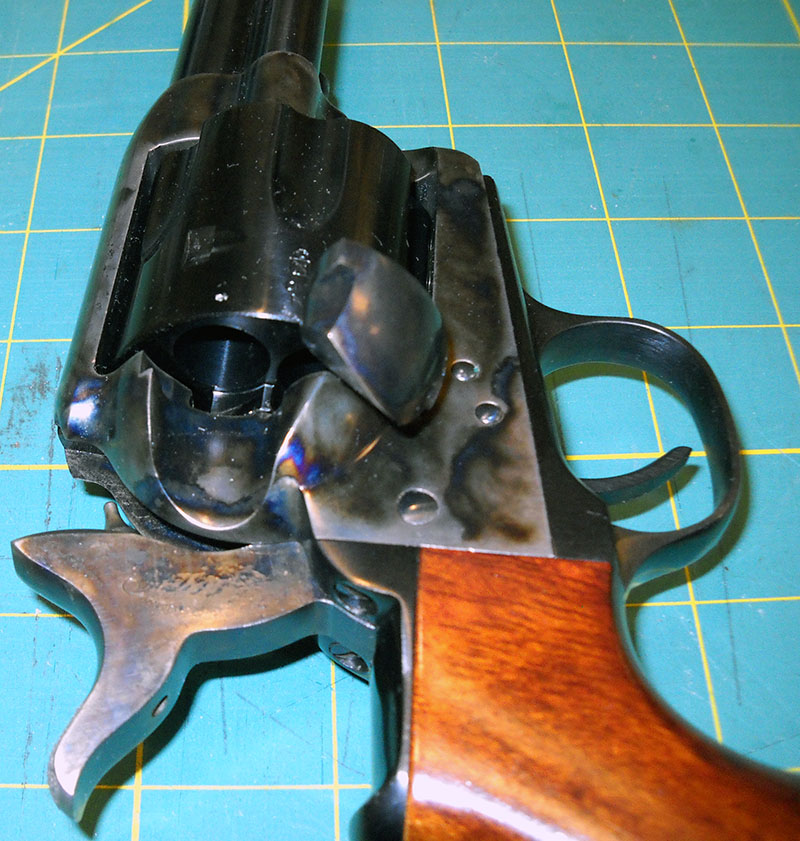
Because the pistol is half-cocked, the cylinder will be free to turn clockwise (viewed from the back), so that the chambers can be lined up with the frame cutout for the gate. Then you just slide in the rounds, one at a time, and advance the cylinder to the next empty chamber.
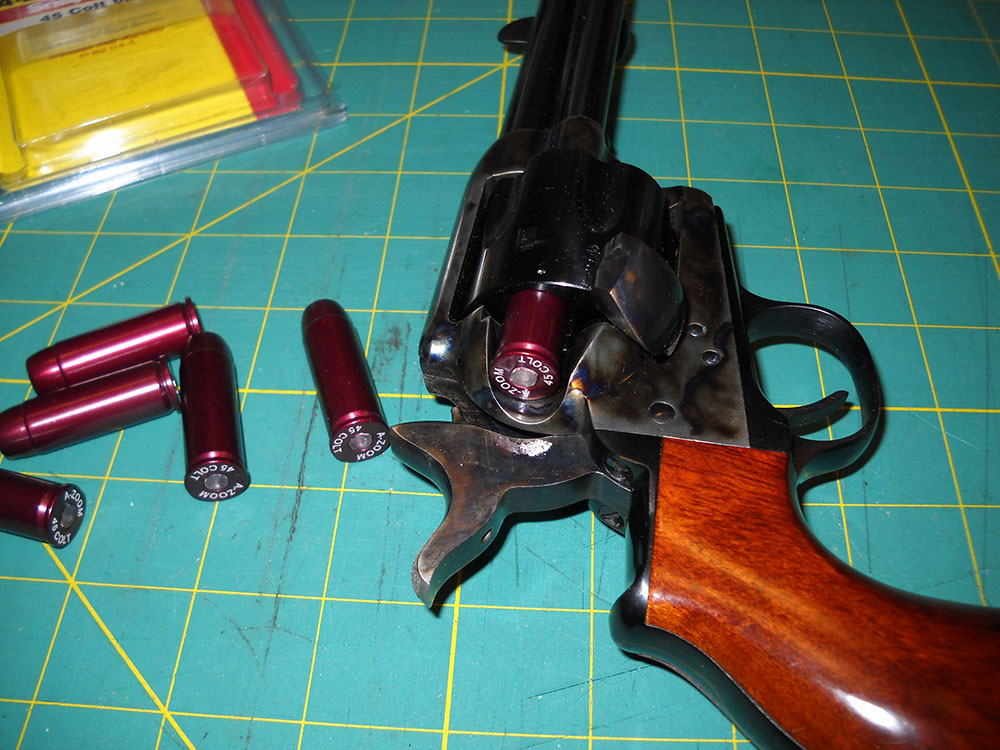
Note that I'm using some nice dummy ammunition here. These are aluminum, machined to the correct dimensions and shape, and have a false primer in them so that the gun they're in can be dry fired without risking firing pin breakage. I didn't have these yet when I used the Inappropriate Ammunition to demonstrate how to load the Remington cartridge conversion last time. Maybe I should re-shoot those photos sometime, although using that ammunition did give me an opportunity to talk about why you shouldn't do that.
Anyway, this particular Thunderer, like the classic version of the SAA that was actually issued to the U.S. Army, is in .45 Colt (sometimes called .45 Long Colt to differentiate it from the shorter .45 Smith & Wesson round the S&W Schofield revolver used). It is not to be confused with .45 Automatic Colt Pistol, which is a rimless, shorter cartridge with a lower maximum pressure, and in fact uses a very slightly smaller bullet (.451 inch as opposed to either .454 inch for lead or .452 inch for jacketed .45 Colt bullets).
.45 Colt and .45 S&W both evolved from the .44 "Army" caliber of muzzleloading days, which specified a .454-inch lead ball to ensure sufficient engagement with the rifling. It's important to note that although these were both fully developed cartridges, they still predated the development of smokeless powder, which means—as discussed last time—a modern .45 Colt cartridge is a very different proposition from the ones that were in stores when the Single Action Army was the latest technology.
Once the SAA is loaded, it's pretty obvious, since the cartridges are so long they can easily be seen from the front.
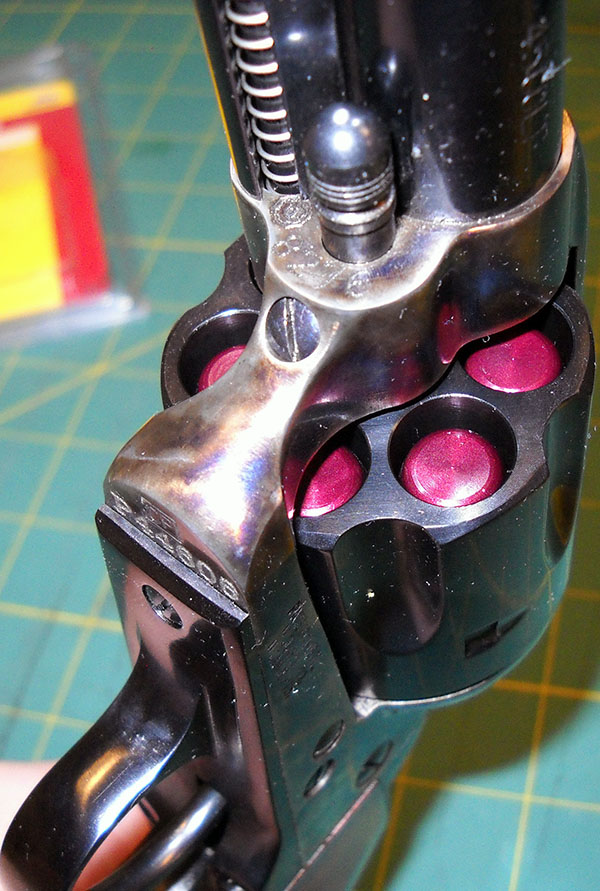
(This shot also provides a good view of the cylinder axis pin, with the nice textured end for helping to pull it out, and the set screw that keeps it from coming out when you don't want it to. In 1896 Colt changed that screw to a spring catch, so that like the 1858 Remington's, the cylinder didn't require a tool to remove.)
To unload (either spent cases, or live rounds you've decided not to shoot), half-cock the pistol again, open the gate, and employ the handy spring-loaded ejector rod mounted below the barrel.
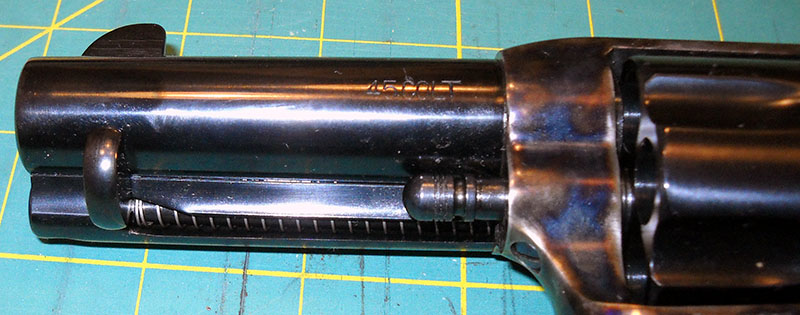
With a chamber lined up with the loading gate cutout, a smart working of the ejector rod will push the empty, or unfired round, in that chamber right out; if it doesn't come all the way (and fired rounds, expanded in the chamber by the powder explosion, sometimes don't), it should at least be pushed far enough that you can easily get hold of the end and pull it the rest of the way out.
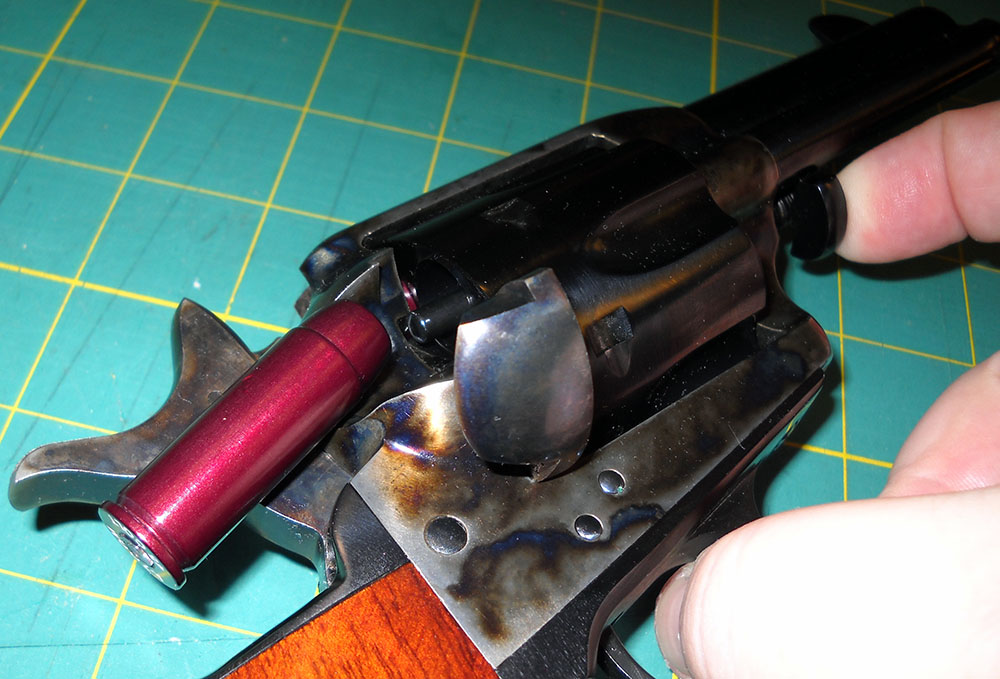
Note that you would normally not hold it the way I'm doing in the photo above. I've got it lying on the table and am holding the trigger guard with my thumb so that you can get a better view of the gate. Normally you would be holding the pistol in your left hand, finger clear of the trigger and thumb out of the way of the ejecting cases, and probably a bit muzzle-high so that gravity can help with the ejection (and so you can give the gun a shake if a cartridge is sticking). This is a little odd for a right-handed shooter, as it means you have to switch hands to unload and load the pistol, but presumably the ability to use the dominant hand for the more precise business of loading and unloading the rounds was deemed to outweigh that inconvenience.²
The spring-loaded, built-in ejection rod is a feature that may seem obvious, but seems to have been really easy for manufacturers of the time to overlook or mess up. The German Reichsrevolvers of 1879 and 1883, for instance, either had to be disassembled to get the empties out, or you'd have to poke them out with a stick, or a pencil, or something. (They were issued with little rods for the purpose. Bets on how long it took every single one of those to get misplaced?) Other gate-loading revolvers made well after everyone should've learned, like the 1895 Nagant, lacked the return spring, requiring the ejector to be worked back and forth by hand.
The photo above also gives a nice view of the color case-hardened finish on the frame and hammer of this particular pistol. This finish combination—color case-hardened frame and hammer, blued barrel and cylinder—was popular on the originals as well.
Here's what it looks like with the hammer at full cock, for comparison's sake:
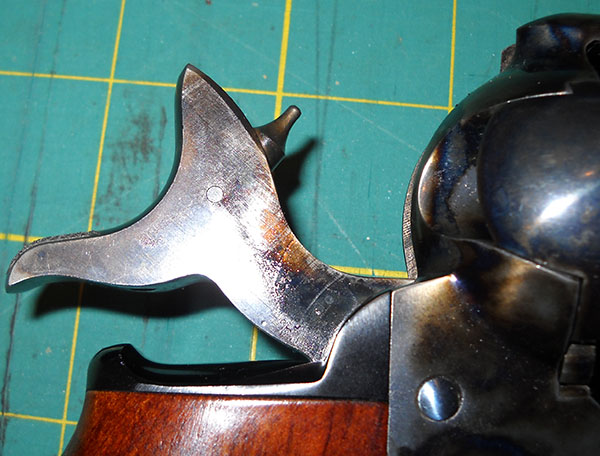
Note the fixed firing pin, just like the original Colts had. SAAs also had no hammer rebound; if the hammer was put all the way down, either by firing or by lowering it (carefully!) with the thumb, it stayed all the way down, which meant that if it were lowered on a live round without setting it off, the firing pin would still be resting directly on the primer of that round. This is not a safe way to carry a firearm, any more than carrying a capped percussion revolver with the hammer down on an unfired cap was.
The SAA's lockwork does contain at least a nod toward this situation, a sort of "quarter-cock" position obtainable by bringing the hammer back juuuuust a tiny bit:
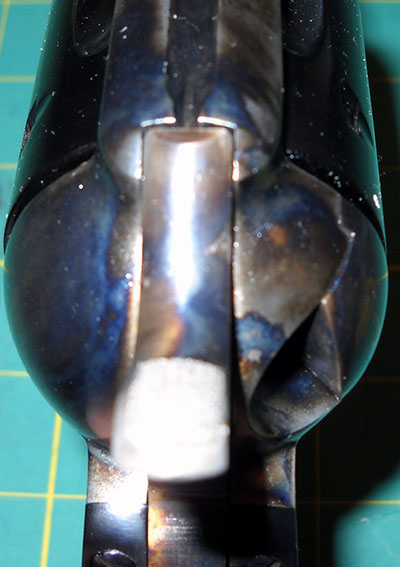
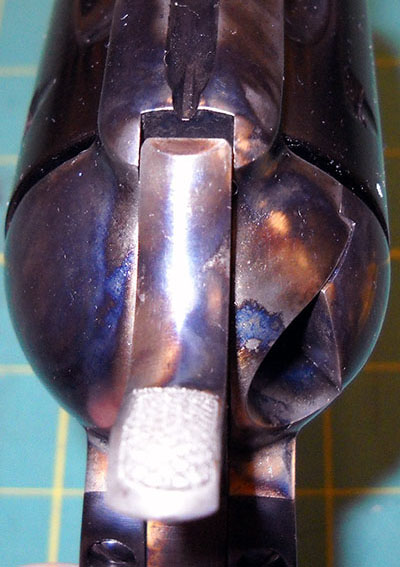
This position sort of anticipates the automatic hammer rebound position some later revolvers (all of which that I can think of are double-action) have, but it's not enough. The hammer isn't positively enough locked in this position; strike it sharply enough, say by dropping the gun on the ground, and it can be forced forward far enough to set off the round. Thus, as with its percussion predecessors, the customary way of carrying an SAA was with five rounds loaded and the hammer down on an empty chamber.
Another design feature the SAA shares with the Remington New Model Army is its rear sight. Where earlier Colts had their rear sight notches built into the hammer itself, the Single Action Army's is a groove milled into the top of the frame. When the hammer is down or at quarter-cock, it covers the groove, so if you try to take aim without cocking the hammer it's very obvious you've missed a step. (There's a good view of this in the two photos just above.)
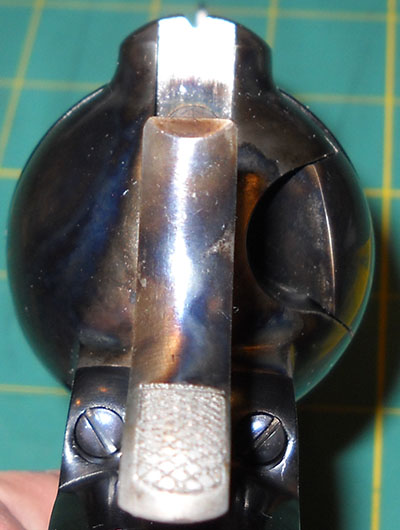
The sight picture isn't terrible, particularly when you consider that it wasn't considered odd for people not to use the sights at all. That is, after all, literally what the phrase "shooting from the hip" means—to draw and fire without raising the weapon above the height needed to clear leather—and it was a common feature of the more informal types of gunfight in the Single Action Army's day. (Less so, one hopes, in Army doctrine, which may be why the pistol has such good sights for the era.)
It should be noted that the sights on this pistol reflect the original 1870s design, as provided for the military. For a while in the 1890s, Colt also made a "Flattop" model, which lacked the rear sight channel and had an adjustable leaf sight installed, for the civilian target shooting market. They also offered, starting at around the same time and lasting into the 1910s, the "Bisley" model, named for an English village known for its firing ranges, and featuring a different grip configuration and a different kind of adjustable rear sight. The sights on civilian SAAs were permanently made larger and more visible in 1920, long after the Army had ceased to use them.
As issued by the U.S. Army, the Single Action Army was chambered in .45 Colt and came with a 7½-inch barrel, similar to the "default" length of the military revolvers that had gone before it. On the civilian market, it was ultimately offered in at least 30 different chamberings, from .22 LR rimfire on up to .476 Eley, a British black-powder cartridge that was the forerunner of .455 Webley (and which, despite its name, had a .455-inch bullet). A popular frontiersman's trick of the time was to order an 1873 Colt and a Winchester Model 1873 in the same cartridge (usually .44-40, despite the latter-day fame of the .45 model), so that one needed to carry only a single type of ammunition.
As for barrel length, the civilian model was originally offered in 4¾0-inch and 5½-inch lengths along with the military-style 7½ inches. Later, custom lengths would be available for order, including the rather preposterous 12½-inch "Buntline" version. This last was, a bit improbably, based on a fictitious gun attributed to dime novelist Edward "Ned Buntline" Judson in a 1931 biography of Wyatt Earp—written by someone other than Buntline, who died in 1886—that turned out to be pretty much entirely fictional. (I said it was improbable.)
Colt has tried to discontinue the SAA twice so far, once in 1941 (when all the company's production was needed for war orders) and again in 1982. Both times, popular demand spurred them to bring it back: first in 1956, as the Western film and television craze was peaking. and again in 1994, as cowboy action shooting started really taking off.
Meanwhile, since authentic vintage Colts have become so valuable and new-production ones are so expensive, any number of other manufacturers have stepped in to fill the gap in the lower end of the market. A. Uberti, the manufacturer of the Cimarron Thunderer we're looking at today, has been making reproduction "frontier" firearms since the 1950s, at first primarily for the film industry. Those vintage guns in Sergio Leone's spaghetti Westerns of the '60s, for instance, aren't vintage guns at all, they're Ubertis. Cimarron (by way of the same Italian manufacturers) has done the same for the American film industry in more recent years, in some ways replacing a 1950s cowboy-guns-for-movies company called Great Western (which was once extremely prominent but was then undercut by the Italians and their own iffy QC and went under in the '60s).
There's some debate in historical circles now as to just how ubiquitous the Single Action Army really was on the frontier, particularly in the 1870s and '80s, when it would still have been the latest thing in military hardware. After all, there were a lot of perfectly good Remington 1858 cartridge conversions out there, as well as converted Colts, unconverted examples of both (and we saw last time why not jumping to cartridges right away could be spun into an advantage), and other, lesser-known Civil War-vintage revolvers almost beyond counting. They would have been readily available to people heading for the frontier, and generally much cheaper than a brand-new Colt. Then as now, Colt's Manufacturing Company was not known for not offering its products at a premium price. While movie and TV cowboys and gunslingers (with a few prominent exceptions) were equipped with Peacemaker copies in large part because they were plentiful and cheap; there is some evidence to suggest they were rarer than that on the real frontier for exactly the opposite reason.
This is not to claim that there were no Peacemakers in the Old West; there certainly were, probably a lot of them. It's just that there was likely to be a great deal more variety in the real gunscape of the late-19th-century American Southwest than mid-20th-century cinema would tend to imply. Not only was there a lot of earlier hardware on the market, by the time the Civil War-vintage cap-and-ball equipment started seriously going out of style, there were other, newer-fangled options available as well. The noted outlaw Billy the Kid, for instance, had a fondness for double-action Colts; when he was killed in 1881, he had an 1877 Thunderer in his hand.
Speaking of the Thunderer, let's have a look at the markings on this one and then talk about why it's called that. On the left side of the barrel is a simple chambering mark:
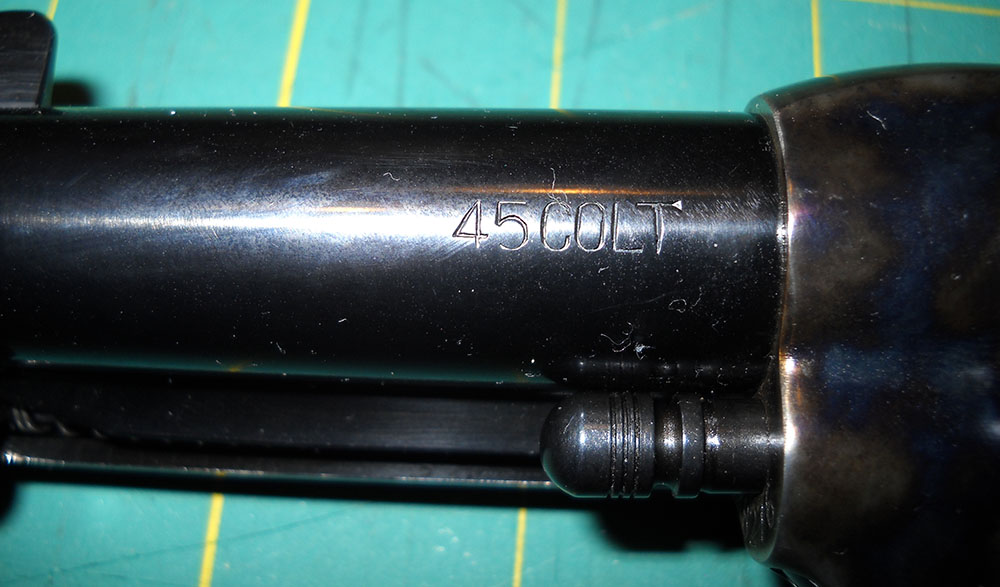
It doesn't say "black powder only," and Colt have been certifying the ones they make as smokeless-ready since 1900, long before Uberti started making reproductions of them. I would assume this means it's fine for modern smokeless loads, but chances are if and when I shoot it, I'll use the mild "cowboy" ammunition that's on the market anyway. (Amusingly, the Cimarron website claims that in the 3½-inch barrel length shown here, the Thunderer is a "splendid" carry gun. I'm going to submit that there are obstacles other than barrel length to that claim and leave it at that.)
The left side of the frame, below the cylinder, lists some patent dates.
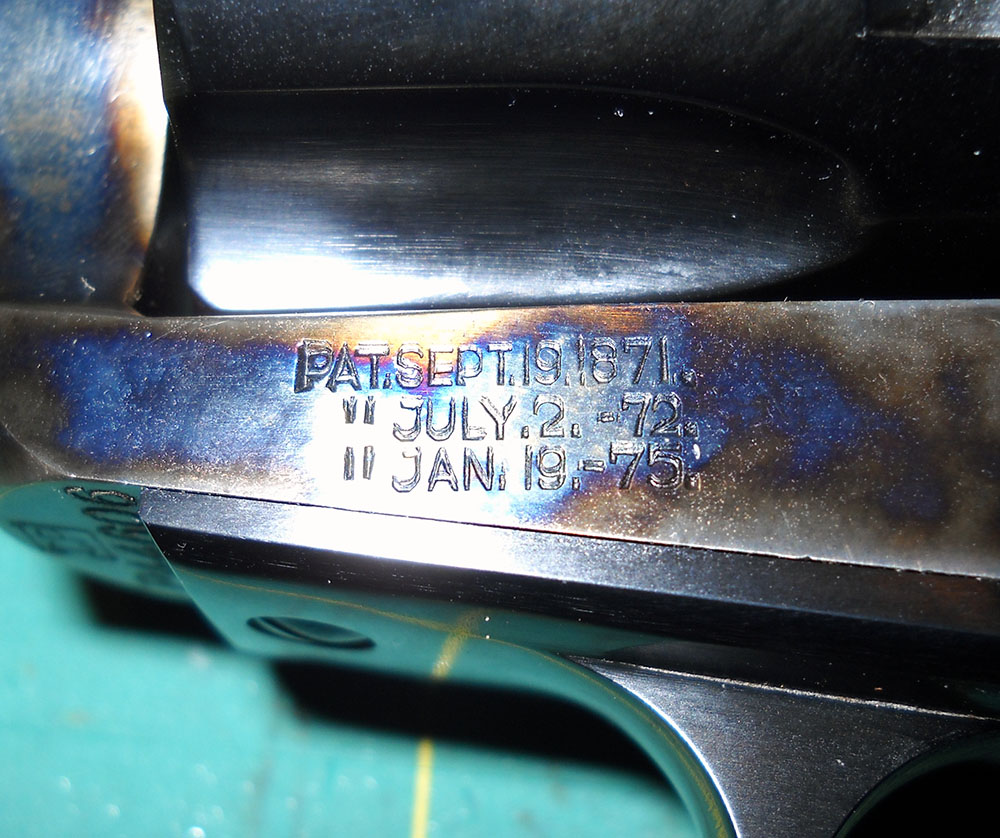
I'm not sure exactly which patents these are referencing. The 1875 one is from after the Single Action Army went into production, so it may refer to the different grip design used in this example, about which more in a moment. This is another good shot of the color case-hardening on the frame, as well.
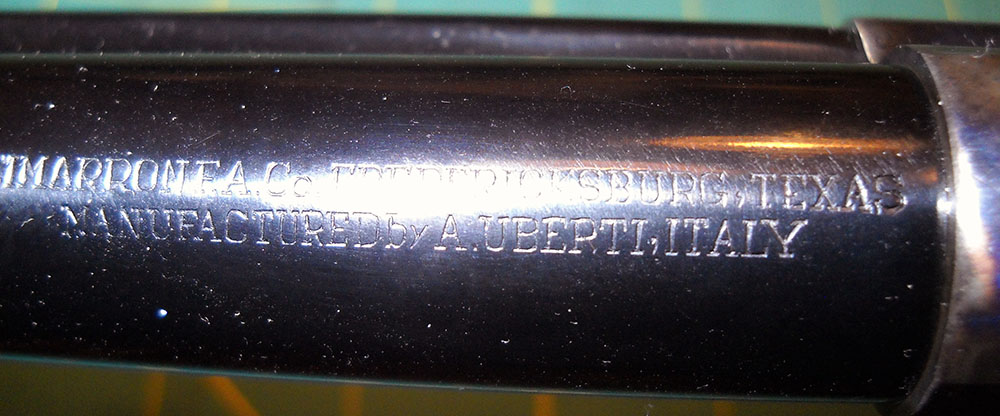
Up on top of the barrel is the most elaborate stamping on the gun; apologies for the slightly wonky framing and the flash. One of these days I really must read up on how one builds a light box. At any rate, we see here that this weapon was sold by the Cimarron Fire Arms Company of Fredericksburg, Texas, and manufactured in Italy by A. Uberti. That, along with the chambering mark on the side and the serial number, takes care of the markings required by U.S. federal law on imported firearms, and you'll note it's rendered in a nice, plausibly vintage typeface. That's an attention to flavor you don't always get on modern reproduction firearms.
Now. As to why it's called the Thunderer: This pistol is actually a hybrid of two different Colt revolvers from the 1870s. From the trigger guard up—basically, the entire working body of the gun—it's a pre-1896 Single Action Army (remember, they changed from a set screw fixing the cylinder axis pin in place to a spring catch in that year). The grip frame, on the other hand, is a slightly-scaled-up copy of the grip of a Model 1877.
The Model 1877 was Colt's first double-action revolver and the first one made in the US to be commercially successful, and its most visually distinctive feature was that "bird's head" grip. Slightly smaller than the SAA, the Model 1877 was never offered in .45 Colt. "Thunderer" was an unofficial catalog nickname attached to the largest version, which was .41-caliber, by one of Colt's distributors (the same one who coined the name "Peacemaker" for the .45-caliber SAA, as it happens); there were also the .38-caliber "Lightning" and .32-caliber "Rainmaker" versions.
I'm not certain why Cimarron chose to mash up the SAA and the Model 1877 in this way rather than just introducing a reproduction of the actual 1877 to their lineup. Perhaps merely for the fun of it. It's described on their website as the personal brainchild of the company's founder, Mike "Texas Jack" Harvey; maybe he just preferred the handling of the classic single-action but liked the feel of the 1877's distinctive grip. Alternately, he might've thought it would be a way to make his company's product stand out visually from the competition, since no one else was making a single-action Colt reproduction that looks like this.
Whyever they did it, I'm pleased they did. It's a handsome beast, and it gave me an opportunity to mention two vintage pistols for the price of one.
--G.
¹ Only one other U.S. state has a state firearm: Utah (perhaps unsurprisingly, the M1911).
² It's also asserted in numerous sources that this was because cavalrymen wanted to be able to hold the gun and the reins with their left hand while loading with the right. That's possible, although it's worth noting that until logistical concerns forced its abandonment, the U.S. Army's cavalry used the break-top S&W Schofield revolver, not the SAA, so I'm not certain I buy that the latter was designed in certain ways specifically for their convenience. Could be, though. Maybe Colt had their eye on that contract all along.